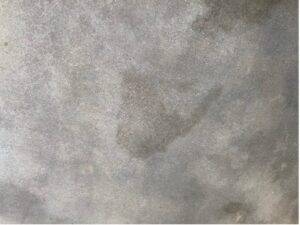Pros and Cons of Stained & Sealed Concrete
by Tom Cramsie
Staining concrete is a decades old means of adding a decorative element to concrete floors with topical sealers being used to lock-in the color. Over time, however, these topical sealers can become scratched, scuffed and worn, requiring maintenance.
As we’ve discussed in past blogs, concrete flooring has become widely popular in a variety of settings. As part of its growing popularity, customers and designers looked for ways to highlight the floors, one of which was adding color to the concrete. This is most often accomplished by adding integral color to the concrete (creating more of a solid color appearance) or by using stains to add transparent color to existing concrete. A topical sealer is then applied to lock-in the color and seal the concrete to create a surface that will resist stains and be easier to clean than bare concrete.
The most important thing to understand about stained concrete is that stains and colorants add transparent color to the concrete. Staining concrete will enhance (not hide) the natural characteristics of the concrete, for better or worse. Stains and colorants will not hide blemishes in the concrete. This cannot be overstated enough. In fact, I’d appreciate you repeating this aloud:
“Stains and colorants do not hide blemishes in the concrete!!”
How to Color Concrete
There are several ways to add color to concrete. One way is to add integral color to the concrete at the batch plant. This will create a mostly uniform appearance. Another option is to use a transparent stain or dye on the existing concrete. Using a stain or dye will create a much more mottled, dynamic looking floor than integral color. While dyes and stains will accentuate any blemishes, the overall effect and look of stained concrete outweighs any slight blemishes. One of the ways used initially for adding color to concrete was acid staining (sometimes referred to as “acid wash concrete”). Most acid stain concrete is created with a mixture of water, acid soluble metallic salts and hydrochloric acid. The acid stain penetrates the surface of the concrete and reacts chemically with calcium hydroxide (hydrated lime). The metallic salts are able to penetrate the surface more easily after being lightly etched by the acid in the stain. The reaction causes the stain to become a part of the concrete permanently and won’t fade, chip, or peel.

While acid staining is a great way to add transparent color to concrete, it does have some drawbacks. Acid stains typically take several hours to react with the concrete and often require multiple applications. Acid stains often leave a large amount of residue being left behind which will need to be cleaned-up prior to sealer application. For the most part, acid stains are generally earth tones and do not offer a wide range of colors.
Water-based colorants have largely replaced acid stains in recent years. Water-based stains are available in a wide array of colors and do not require the same reaction time as acid stains. Most often, water-based colorants do not leave a lot of residue and can be sealed as soon as they dry, resulting in labor savings and efficiency. Most importantly, water-based colorants are environmentally friendly and pose little health threat to installers.
Choosing the Right Concrete Sealer
There are many options when it comes to choosing the right sealer for stained and sealed concrete. As is often the case, price is generally a deciding factor. More important, however, is the setting and amount of traffic the floors will handle. For light residential use, solvent and water-based acrylic sealers are often appropriate. For high traffic areas such as restaurants, schools and retail settings, a more durable epoxy or urethane coating is more appropriate.
Applying a topical sealer will, in most cases, give the concrete a “wet” look which will bring out the color of the stain. Applying a sealer will also seal the concrete to create a more easily cleaned and stain resistant surface. Most topical sealers provide a gloss finish while there are some sealers that can provide a matte finish if high gloss is not desired.
There are hundreds, if not thousands, of topical sealers on the market with each manufacturer having their own versions. When it comes to sealing concrete, the most commonly used sealers are:
- Water or solvent-based acrylics
- Water or solids-based epoxies
- Water or solvent-based urethanes
In all, water-based sealers pose less threat to the environment and installers than solvent-based sealers, which omit volatile organic compounds (VOCs) as they dry. These VOCs are highly flammable which will require the area to be well ventilated and installers will have to wear a respirator during application. One key difference between water-based and solvent-based sealers is their appearance after application and cure. Solvent-based sealers tend to penetrate the surface very well which results in a glossier finish that enhances the color of the stained concrete. Water-based sealers will have a milky white appearance as they dry and tend to provide a lower-gloss, matte finish. If the customer would like to make use of a water-based acrylic but still wants a high gloss finish, a high traffic floor finish (wax) can simply be applied). Any of the above-mentioned topical sealers are susceptible for scratches and scuffs. Over time, it is possible the sealer will need to be lightly sanded and reapplied. Wax can also be applied and act as a sacrificial layer to protect the sealer.
Stained & Sealed versus Polished

Polished concrete does not make use of the same topical sealers mentioned above used for sealing the floor after staining. Polished concrete floors often make use of “guard” products in lieu of topical sealers. These guards (aka stain preventers) are applied in very thin coats (typically 1,000+ sf/gal) and are then burnished to enhance the shine. As a result, the guard products are less susceptible to scratches and scuffs.
